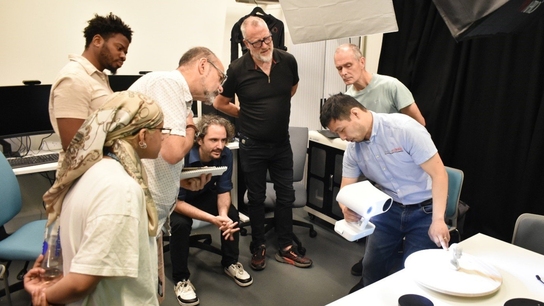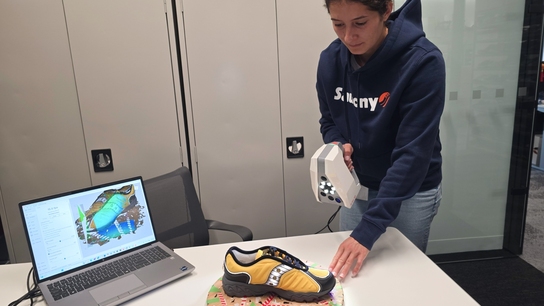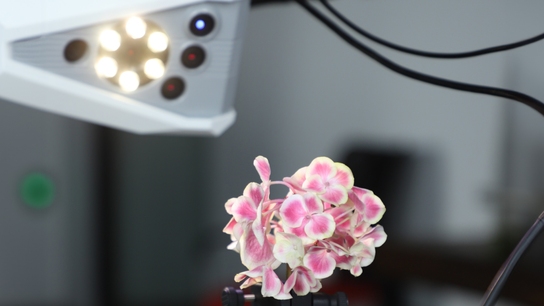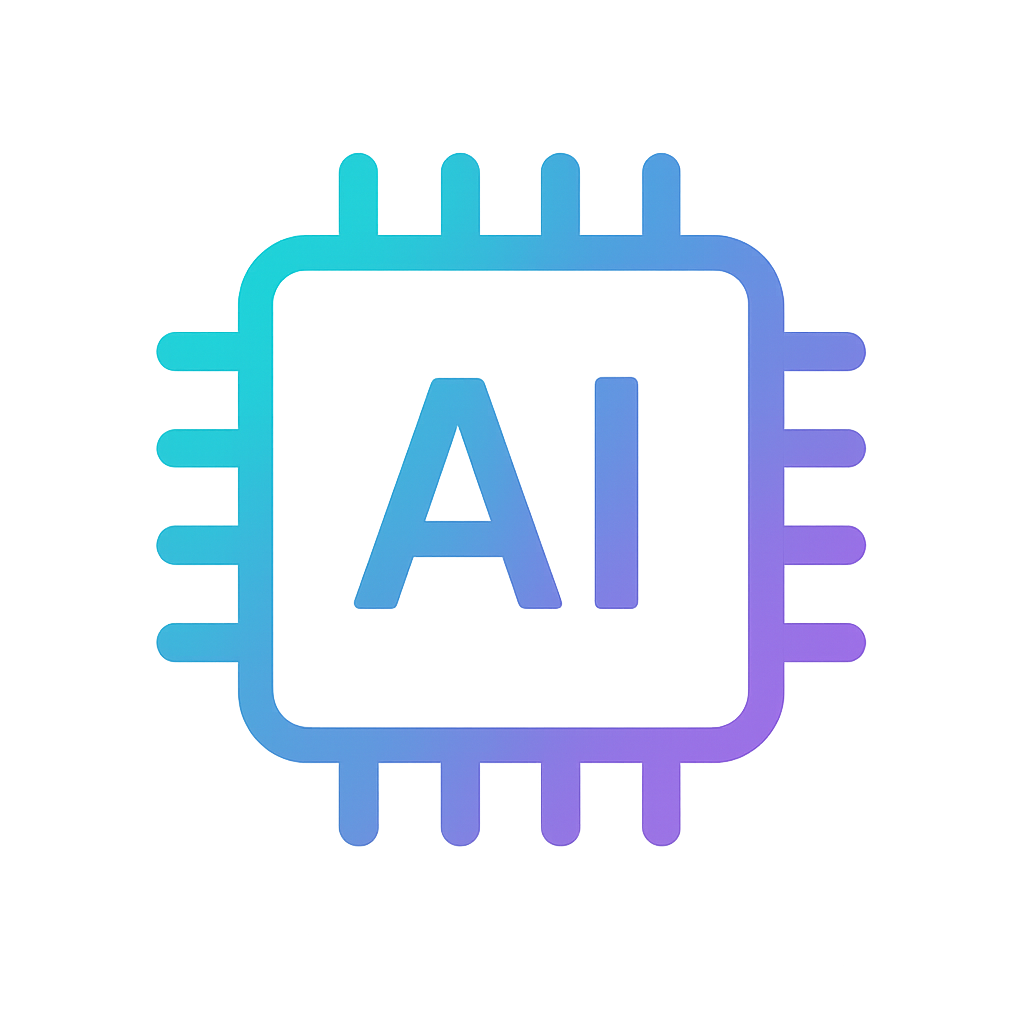The paleontologist’s secret weapon: How Artec 3D scanning brought the Asian Tyrannosaurus back to life
Challenge: Researchers at Zhejiang Museum of Natural History needed to digitize a fragile, newly discovered tyrannosaurus dinosaur fossil with high precision for preservation and in-depth analysis.
Solution: Artec Eva, Artec Space Spider, Artec Studio
Results: While Artec Eva was used to capture the wider fossil contact-free, Artec Space Spider picked up the skull’s more intricate structures and textures. The resulting high-quality model not only enhanced the museum’s exhibition, it allowed them to identify a new genus and species of tyrannosaurid: Asiatyrannus xui.
Why Artec 3D?: Artec 3D scanners offer sub-millimeter accuracy and vivid color capture, without any need for targets. The devices are ideal for turning delicate fossils and cultural artifacts into ultra-realistic 3D models, breathing new life into ancient relics, and ensuring their legacy is maintained in the virtual world.

Restoration of Asiatyrannus xui. Courtesy of Zhejiang Museum of Natural History
Tyrannosaurids – apex predators of the Cretaceous
Tyrannosaurids are among the most iconic, unique, and thoroughly studied dinosaur groups. Around 30 species are known, spanning from the Late Jurassic to the end of the Cretaceous (150 to 66 million years ago).
These dinosaurs are known for their robust skeletons, massive heads, and powerful but short forelimbs. The most famous member, Tyrannosaurus rex, reached up to 13 meters in length, weighed over eight tons, and had a bite force of 58,000 newtons, making it one of the most formidable land predators in Earth’s history.
Most tyrannosaurids have deep-snouted skulls – which are relatively short from front to back but tall vertically – giving them a boxy appearance and incredible bite strength. This includes species like the T. rex and Tarbosaurus.
In the Gobi desert of Central Asia, scientists have now discovered that deep-snouted Tarbosaurus and long-snouted Alioramus once coexisted. The former was larger in size, suggesting the two species occupied different ecological niches. Interestingly, the size relationship was reversed in southeastern China. It may not have evolved into a full adult dinosaur, but Asiatyrannus xui had already passed its fastest growth phase and was still only about half the length of Qianzhousaurus, suggesting that they occupied different ecological niches and avoided direct competition.

Fossil skull of Asiatyrannus xui. Courtesy of Zhejiang Museum of Natural History
Tyrannosaurid fossils have primarily been found in North America, Mongolia, and northern China, with relatively few discoveries elsewhere. This find by the Zhejiang Museum offers valuable insights into tyrannosaurid diversity and evolution during the Cretaceous period.
Bringing prehistoric beasts ‘back to life’
Throughout the history of life on Earth, tyrannosaurids have always captivated researchers with their size and status as apex predators. In the case of Asiatyrannus xui, the fossil includes a nearly complete skull (47.5 cm long), tail vertebrae, and hindlimb bones.
Traditional documentation methods fall short of capturing the fossil’s complex structures and finer details. Moreover, the fossil’s weight makes frequent movement and repositioning impractical, hindering thorough examination.
To address the conflict between fossil fragility and research demands, the Zhejiang Museum team evaluated several 3D scanning options before selecting an Artec 3D solution. The project was led by Dr. Zheng Wenjie, Deputy Director of the museum’s Earth Sciences Department, with Gold-certified Artec Partner Ningbo FLD-TECH providing on-site training and ongoing technical support.

One of the project researchers capturing a fossil with Artec Eva. Courtesy of Zhejiang Museum of Natural History
To begin with, the team deployed Artec Eva, Artec’s long-serving, lightweight, flexible handheld 3D scanner, to capture data from the entire fossil.
They then used Artec Space Spider, which boasts an accuracy of up to 0.05 mm, to scan the skull in fine detail. Powered by blue-light technology, the device is designed specifically for capturing complex geometry and fine edges. With the fossil, it was able to meticulously reproduce its uneven surface marks, as well as the naturally formed textures and patterns created during the weathering process.
The non-contact, target-free nature of Space Spider also ensured that the specimen remained unharmed. The process was fast and seamless – even non-experts could use the scanners with ease, removing some potential roadblocks in the workflow.
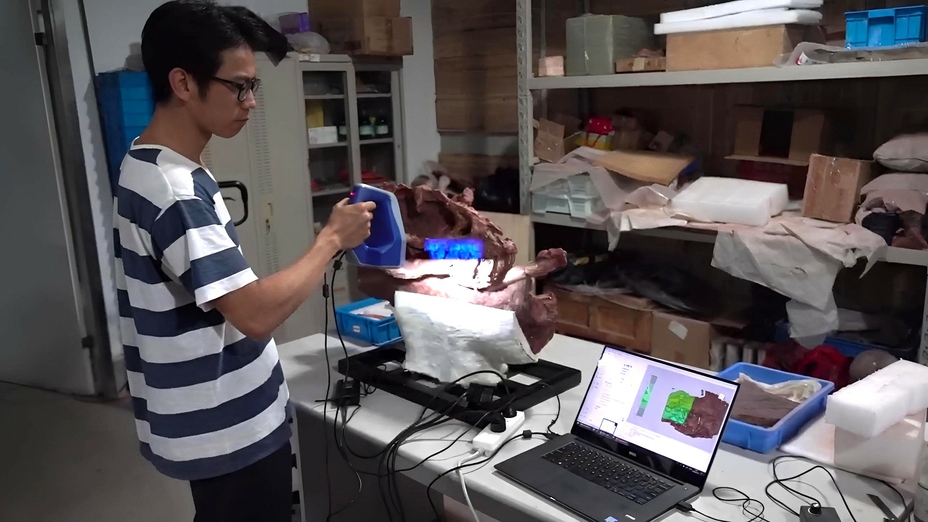
Artec Space Spider being used to scan the dinosaur skull. Courtesy of Zhejiang Museum of Natural History
Once the 3D surface data was collected, Artec Studio software was used to align and merge the full-body scan with the high-resolution skull data, creating a complete digital reconstruction of the dinosaur. Researchers could then take precise measurements and conduct analyses with the 3D model, saving substantial time and providing robust support for their studies.

Skull mesh data in Artec Studio. Courtesy of Zhejiang Museum of Natural History
Artec 3D scanners precisely capture fossil specimens in a non-contact, non-destructive, and comprehensive manner. This not only overcomes the research challenge of limited access to delicate and valuable specimens but also enables permanent digital archiving through high-precision 3D data.

Vivid 3D model of the skull rendered in Artec Studio. Courtesy of Zhejiang Museum of Natural History
Ultimately, these incredibly detailed scans provide a reliable foundation for simulating species evolution and virtually restoring damaged areas and offer a profound insight into the transformative role of digital technology in paleontological preservation.
Lending dino fossils a new lease on life
Paleontological research has traditionally been limited to institutions and museums, with fossil specimens rarely shared. But once digitized, fossils can be replicated infinitely and shared worldwide.
In scientific research, 3D scanning reveals the intricate structures and rich details of fossils, allowing researchers to study them based on precise digital data. In museums, lifelike 3D models give visitors an up-close look at ancient creatures, so they can better understand them. In educational outreach, the integration of VR technology enables learners to travel back in time for an immersive experience. Even in the film industry, these models can be combined with CGI to create breathtaking visual spectacles on the big screen.

Skull reconstruction of Asiatyrannus xui. Courtesy of Zhejiang Museum of Natural History
As paleontologists shift from microscopes to digital workstations, and museum showcases extend into the virtual space, 3D scanning is reshaping the way we study the past and protect cultural heritage, building a bridge between the past and the future.
The tyrannosaurid research project at the Zhejiang Museum of Natural History demonstrates that 3D technology not only pushes the boundaries of our understanding of ancient life but creates a digital ‘Noah’s Ark’ that safeguards our shared legacy for future generations.
Scanners behind the story
Try out the world's leading handheld 3D scanners.

